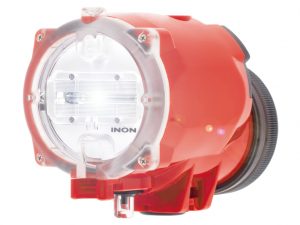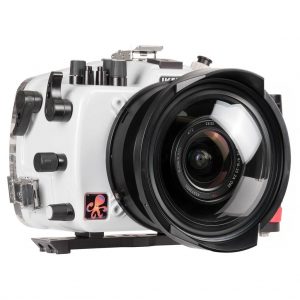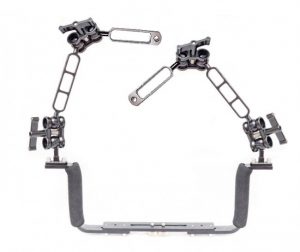What camera should I get? A guide to buying your first camera from a full time photographer
As a full time photographer for dive centers the one question I get asked more then any other is: what underwater camera should I get?

The answer goes beyond the camera and will depend on a few factors, most importantly being: what type of photography are you interested in? There is wide angle, close focus wide angle, marine life or divers, Portrait, macro and video – professional or hobbyist. In the world of underwater photography the accessories other then the body itself are actually extremely important factors. Namely the type of:
- Lens
- Strobe
- Housing
- Arms
- Floats
- and even lanyard/leash
are all decisions you are going to have to make. I spent months pulling my hair out and emailing back and forth with the staff at Mozaik, researching, price matching until I finally came to a conclusion. Thank you for your patience Mozaik 🙂

I would like to help to try and take some of the mystery and confusion out of this process by giving you a few tips. For this article I will tackle wide angle – (marine life and divers) since this is what I know best from my work.
If you don’t want to learn why and just want to see what I started with scroll down to the bottom.
First off, the quick and to-the-point answer that most photographers will give you is: ANY CAMERA… if you know how to use it.
If you know how to work with your camera in manual, understand composition and have great buoyancy then this is mostly true. The exception to this, whether you are going: point and shoot compact, mirrorless or full frame DSLR is both :
- The FOV (field of view) of the lens
- External strobes.
Two very important factors, if not the most important when it comes to wide angle underwater photography.
First to understand the terminology in simple terms:
FOV and lenses
Field of view is a way of determining how much area around the lens can be captured. This typically relates to a lens with a fish eye type curvature (more about that later) similar to a GoPro. Wide angle is measured in degrees such as 130 rather then mm. One 16mm lens might have a wider field of view than another (capturing more of the scene) but that world typically cause barrel or pincushion distortion as the lens is bending the image like a bowl e.g. fisheyes and gopros. This can be desirable or undesirable depending on the look you are going for. In my opinion when dealing with human subjects it can be unflattering for the subject to have hands, legs and dare I say stomach stretched with too much distortion. This is where the classification of a rectilinear and curved lens comes from. A rectilinear lens is a photographic lens that yields images where straight features, such as the walls of buildings, appear with straight lines, as opposed to being curved. In other words, it is a lens with little or no barrel or pincushion distortion. When photographers talk about distortion in a lens it relates to this phenomenon. This can be somewhat corrected in post-processing.

I know pros who use both well but there is a larger learning curve working with a fisheye lens.

The other factor to consider when choosing a wide lens would be corner softness. Without getting too technical, corner softness is when the edges and corners of an image become blurry (or soft). This happens more so at wider apertures (lower f-stop) and with lower quality lenses. This is due to the design of the lens and optics. Shoot for a lens that is sharpest from edge to edge within your price range. Here are a few examples below of soft corners.









External strobes
If price is a concern for you and you need to sacrifice somewhere make sure you get the best strobes you can afford, even if you only start with one. This is the one piece of equipment that can follow you as you upgrade rigs and will give you the most impact on your images. This is what will make your photos shine! (…sorry for the pun)




 As we all know from our open water course light does not travel far underwater. The full spectrum ROY G BIV only penetrates about 5 meters and that is the light coming from a huge burning star in the sky. From our little strobes we are trying to illuminate as much of our subject as possible with the full spectrum of white light to bring out all of those beautiful natural colors… some of which we don’t even get an opportunity to see naturally with our own eyes when we are deeper then 5 meters. This is what gives underwater photos (especially of colorful reefs and people) their amazing ultra realistic look. Regardless what brand you choose I would recommend going for their current flagship model. If you can’t afford 2 then stick with one and upgrade later. You will be much happier now and in the future and your photos will get the proper amount of light they need. If you can only afford one, no worries! To give you a little comfort in that decision look at my instagram photos from 2017. http://instagram.com/adlephoto Most were shot with 1 strobe. In-fact in some situations (such as low visibility) it is actually better than using 2 strobes.
As we all know from our open water course light does not travel far underwater. The full spectrum ROY G BIV only penetrates about 5 meters and that is the light coming from a huge burning star in the sky. From our little strobes we are trying to illuminate as much of our subject as possible with the full spectrum of white light to bring out all of those beautiful natural colors… some of which we don’t even get an opportunity to see naturally with our own eyes when we are deeper then 5 meters. This is what gives underwater photos (especially of colorful reefs and people) their amazing ultra realistic look. Regardless what brand you choose I would recommend going for their current flagship model. If you can’t afford 2 then stick with one and upgrade later. You will be much happier now and in the future and your photos will get the proper amount of light they need. If you can only afford one, no worries! To give you a little comfort in that decision look at my instagram photos from 2017. http://instagram.com/adlephoto Most were shot with 1 strobe. In-fact in some situations (such as low visibility) it is actually better than using 2 strobes.



Camera
Ok, so the big question is what camera should I get. Assuming you do not already own a camera I would suggest starting with a compact camera such as: Sony RX100 series or the Canon G7x. Recent developments in the past few years have brought image quality of compact cameras up to par with any entry level DSLR. Some compacts actually surpass in performance with both image quality and video.
The advantages are: Simplicity, price and size. With a compact you don’t have to figure out lens and port configurations. You will save A LOT of money not having to buy different lenses and ports and extensions, zoom and focus rings etc. The housings themselves also tend to be much more affordable. It’s more of a simple out of the box solution that is much smaller, lighter and easier to transport. Also… it is much easier to sell if you plan to upgrade in the future. I am 100% happy that I decided to start professionally with a compact camera system and then upgraded once I had a need to.
Housing



Housings typically come in 3 materials: aluminum, polyurethane/polycarbonate and clear ABS plastic. If you are shooting daily I would highly suggest an aluminum housing. They are much more rugged and will hold their value longer. If you are only planing on a few trips a year then you should be fine with the plastic alternatives. Make sure the housing can support a good wide angle wet lens (Read more about Wet lenses HERE) and the types of strobes you would like to use. The final note about housings is to try and choose a model with some type of leak alert such as a vacuum alarm. This allows you to pump the air out of the housing and gives you a visual and auditory indication that the housing is sealed and protected. This is great for piece of mind. It helps to keep the unit from flooding and if there is an issue before you enter the water the indicator will alert you.
Accessories

Arms and floats
Another consideration will be the types of arms, clamps and floats (if needed) you will have to purchase. Arms are what attach to the strobes and clamps are what attach the arms to the housing and one another. This is where you can save some money and go with 3rd party manufacturers. There is a big savings when not purchasing name brands and it’s a simple peice of metal that does not have any effect on the quality of your images. Floats are what you will need to compensate for the negative weight of your rig in the water. There are foam floats that attach to your arms made from a special foam that does not compress or you can buy arms that are sealed with air giving them a positive buoyancy rating. What weight you will need to offset will completely depend on what rig you end up buying so seek the advice of your sales rep. Most underwater camera equipment by trusted manufacturers should have their underwater weight listed. I would suggest keeping your rig a tad bit negative. For safety reasons I would rather have my camera sink where I can locate it then have it shoot up to the surface.


Lanyard
Last but not least is your lanyard. I would highly recommend having something to attach the camera to you especially for beginners. The obvious reason is so you don’t loose it the less obvious is to transfer your camera to and from the boat staff and incase you need free up both of your hands for some reason eg. entanglement issue, deploy an SMB or to make cool bubble rings to impress your friends 🙂
My first camera
After months of deliberation and going through all of the different options I decided to go with the Sony RX100iv – a very high quality compact camera.

Even though I shoot with a big DSLR on land, the convenience, portability and price pushed me in the direction of the RX100iv. I don’t feel I sacrificed one bit on image quality and was very happy with my decision. I paired this with 2 INON Z-240 strobes (now discontinued and replaced with the Z-330) a Nauticam housing with vacuum alarm and a Nauticam WWL-1 wet lens. The lens is very heavy so you will definitely need some type of floats on your rig. Nauticam also makes a proprietary buoyancy collar that fits around the lens for just this purpose, although it works well I found that it made the lens too big and took away from the compactness that attracted me to it in the first place. I used both foam floats and large buoyancy arms from INON and both did the trick.
I hope this helps. If you have any questions please feel free to ask your sales rep, they can be an invaluable source of information and save you a lot of time with trying to figure out the correct set-up that will fit the type of photography you would like to pursue. Also there are a lot of UW photography forums and facebook groups where divers love love love to talk about equipment and give their opinions on what they think are the best products. They will not hesitate to give you honest feedback especially if they are unhappy with something. Happy shooting, welcome to the amazing world of underwater photography, and please remember to limit your single use plastics 🙂
- 10 Things You Must Know Before Starting a Career as an Underwater Photographer – April 15, 2021
- What is the Best and Fastest Way to Learn Underwater Photography – September 8, 2020
- How to Extract Perfect Still Photos from 4K Video – May 14, 2020

 USD
USD

